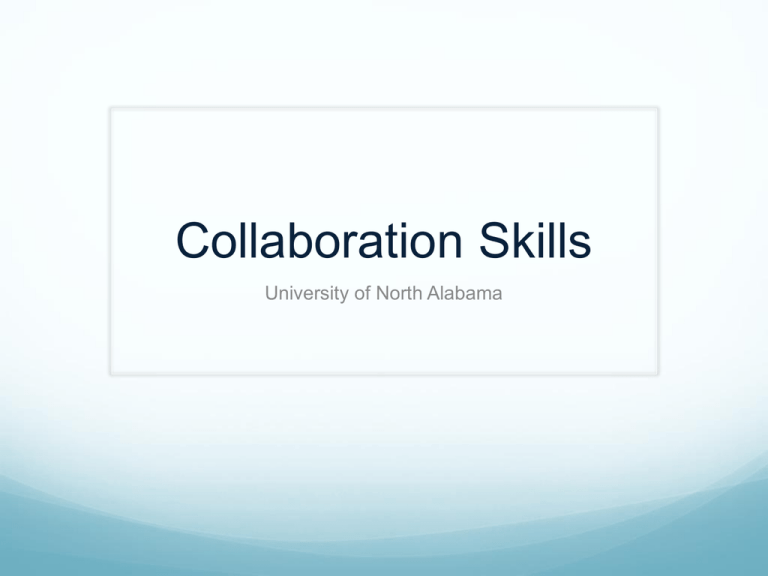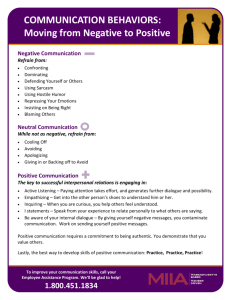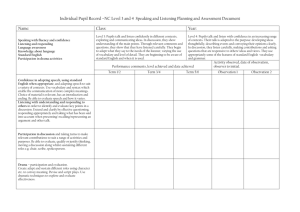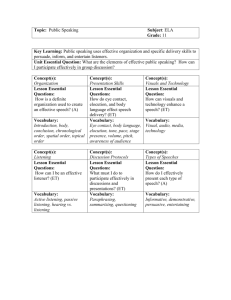Collaboration Skills - University of North Alabama
advertisement

Collaboration Skills University of North Alabama Today’s Goals Understand and implement skills to successfully communicate and collaborate Collect the positive lessons learned from past collaboration efforts Reflect, collect and learn from experiences this week Brainstorm necessary support to develop successful collaborations Expectations Take 2 minutes to think about your expectations for today. Using one post-it note for each idea and working silently, write down your individual expectations. Organize these notes in the center of your table, read colleagues’ ideas as you go, and cluster ideas as best you can with little discussion. Talking with your team members, assign a category title to each cluster and resolve differences. Sharing Whip Around Move around the room, calling on one participant at a time. Have participants share one of their responses, their team responses, or team categories. When called on, participants should not repeat a response; they must add something new. Keep your responses short and to the point so we can include as many responses as possible. Reflection For the past two activities (Expectations and Sharing), the activities were structured to ensure balanced participation and support collaboration. Can you identify some of the structures used to ensure balanced participation and support collaboration? Talk to your table group. Collaboration and Communication Skills What is necessary for successful collaboration? Skills Norms Knowledge Four Capabilities (Skills) To know one’s intentions and choose congruent behaviors To set aside unproductive patterns of listening, responding, and inquiring To know when to self-assert and when to integrate To know and support the group’s purposes, topics, processes, and development Garmston, R. and Wellman, B. (2009). Adaptive schools: Developing collaborative groups 4 Capabilities Jigsaw Count off 1-4 at your tables. Move into new groups. Read the handout silently, highlight and take notes as you go. Once all of your group members are done reading, share ideas that stayed with you, concepts that inspired questions, or elements that were confusing. Be prepared to share with the mixed group. Reflection How did the Jig Saw activity support practice and implementation of the 4 Capabilities? Intention and Behavior Clarity of intention in the moment and over time drives attention The what and how a group member participates The source of impulse control, patience, strategic listening, and strategic speaking The foundation for flexible and effective behavior Listen, Respond, and Inquire Set aside autobiographical listening, responding, and inquiring - “ME TOO!” Set aside inquisitive listening, responding, and inquiring - “TELL ME MORE!” Set aside solution listening, responding, and inquiring “I KNOW WHAT TO DO!” Self-assert and Integrate When to challenge; when to go with the flow Self-assert- does not mean self-focus refocusing the group on a topic or on a process reminding others of the purpose speaking up and advocating Integrate - align energy with the meeting suspend judgments and counter arguments follow the flow of logic and reasoning Know and Support the Group All ongoing groups need to balance three simultaneous agendas: Task focus - group’s ultimate purpose Process skills development - expand its capacity for handling more complex tasks Group development - continuum from novice to highperforming Seven Norms of Collaboration Pausing Paraphrasing Probing for specificity Putting ideas on the table Putting inquiry at the center Paying attention to self and others Presuming positive intentions Garmston, R. and Wellman, B. (2009). Adaptive schools: Developing collaborative groups Exploring New Information Delve and Dialogue Read the selection about 7 Norms and make connection with some aspect of your work at UNA. With your elbow partner, share some of your connections. Honor the spirit of inquiry with pausing, paraphrasing, and probing. Structured Group Sharing One group member shares an idea No interruptions or questions during sharing Set aside unproductive listening, responding, and inquiring You will have 1 minutes to share Your group will have 1 minutes for responding: Paraphrasing Probing for specificity Dialogue vs. Discussion Dialogue: A reflective learning process in which group members seek to understand one another’s point of views and deeply held assumptions. This is a listening practice. Discussion: Focuses on cause and effect and the ripple effects of proposed actions and solutions. Requires mental and emotional flexibility. Decision-making process Knowledge of the group’s authority Standards for orderly decision-making meetings Garmston, R. and Wellman, B. (2009). Adaptive schools: Developing collaborative groups Working Together Pair Share Determine A partner and B partner. Both partners: Skim introductory section A partner: Read & take notes about Dialogue (pg. 2) B partner: Read & take note about Discussion (pg. 4) Share what you learned with your partner about Dialogue or Discussion. Why might it be important to understand the difference? Reflection How might you apply the concept of Dialogue and Discussion to any future collaborative work? As a student? As faculty? As a staff member? Final Reflection How did the 4 Capabilities and 7 Norms influence participation in the activities? How was your understanding of the Dialogue and Discussion different from other collaborative experiences? If you are working in a group and are the only member who knows these skills and norms, how might you influence the group? Lessons Learned Work with your previous Capabilities group. Think about what lessons you have learned and would like to share with others from past collaborations. Share with your table group. Practice 4 Capabilities and 7 Norms Pausing, Paraphrasing, Probing, and Putting Ideas on the Table Make notes. Lessons Learned Transition Move to mixed 1-2-3-4 groups Take your notes with you Review of 7 Norms Goals: Clarify the thinking of the speaker (paraphrase) Understand the speaker (probing for specificity) Lessons Learned Part 2 Practice 4 Capabilities and 7 Norms Each member shares information. Others: Clarify the thinking of the speaker (paraphrase) Understand the speaker (probing for specificity) Determine the most relevant ideas Create a poster of the most relevant ideas Select one group member to share with whole group Facilitator Move: PAG/PAU Lessons Learned Sharing One group member shares group’s ideas No interruptions or questions during sharing Set aside unproductive listening, responding, and inquiring You will have 2 minutes to share We will have 1 minutes for responding: Paraphrasing Probing for specificity Reflection After reading and hearing about the 4 Capabilities, where do you want to be as a collaborative team member? List a description of yourself under “Desired State.” Complete the graphic organizer: What do you need? Existing State Desired State What capabilities should you work on? List what you need or what capabilities you would like to work on. Reflection Where are you? Fold a piece of paper in half. Label the left side “Existing State” and the right side “Desired State.” Take a few minutes and think about where you see yourself as a collaborative team member now. What do you currently do to contribute or detract from a collaborative effort? Write your thoughts under “Existing State.” Facilitator Moves: Count Down






